The Secret Ingredient That Will Make Your Risotto Taste Better
Perhaps you've heard of adding espresso powder to chocolate cakes to make them richer, or adding mayonnaise to your pancakes to make them fluffier. Sometimes all it takes to amp up the flavors and textures of your dish is the addition or substitution of a single ingredient. For risotto, that ingredient is salted water, according to chef and writer Naomi Pomeroy (via The Kitchn). If you've ever made risotto before, the recipe that you followed most likely called for broth or stock, but the truth is that salted water produces better results.
Store-bought stocks and broths vary from brand to brand, and this makes it harder to control the flavor and color of your risotto. Salted water on the other hand will help highlight the flavor of the rice without overpowering it. Furthermore, as The New York Times explains, making stock is already built into the process of cooking risotto. Whether it be for a seafood risotto or a mushroom risotto, as soon as you add liquid, you're creating a stock, because as food writer Mark Bittman points out, any sort of stock is just the drawing out of flavor from a solid food into water — be it vegetable or meat.
How much salted water should you add?
Pasta water is generally supposed to be "as salty as the sea," but risotto instead should be only lightly salted. Per The Kitchn, chef Naomi Pomeroy recommends a ratio of six cups of water to 1 tablespoon of salt. Keep in mind that this should be adjusted according to whether or not you're planning to add a naturally salty ingredient such as cheese or seafood, because according to Food52, whatever liquid you add gets reduced, and you don't want to end up with a risotto with highly concentrated salt.
Then once your water is properly salted, you'll need to bring it to a boil and add it to the rice as the final step. As Food52 points out, the key is getting the most amount of starch out of your rice. This means adding enough water that you don't end up with rice glued to the bottom of your pot. For a creamier risotto, resist adding additional water to the pot while stirring. Just as you would with any risotto, the salted water approach requires a bit of monitoring, but the payoff is a risotto that's creamy and flavorful.

